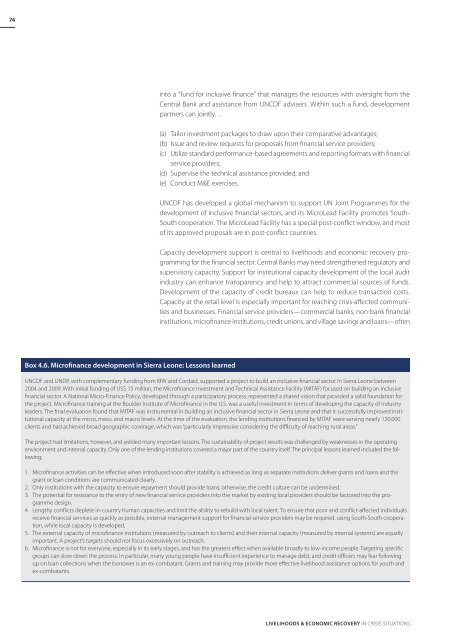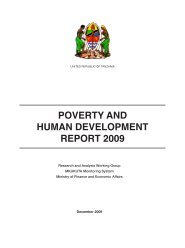Download PDF (4.08 MB) - ReliefWeb
Download PDF (4.08 MB) - ReliefWeb
Download PDF (4.08 MB) - ReliefWeb
Create successful ePaper yourself
Turn your PDF publications into a flip-book with our unique Google optimized e-Paper software.
74<br />
into a “fund for inclusive finance” that manages the resources with oversight from the<br />
Central Bank and assistance from UNCDF advisers. Within such a fund, development<br />
partners can jointly…<br />
(a) Tailor investment packages to draw upon their comparative advantages;<br />
(b) Issue and review requests for proposals from financial service providers;<br />
(c) Utilize standard performance-based agreements and reporting formats with financial<br />
service providers;<br />
(d) Supervise the technical assistance provided; and<br />
(e) Conduct M&E exercises.<br />
UNCDF has developed a global mechanism to support UN Joint Programmes for the<br />
development of inclusive financial sectors, and its MicroLead Facility promotes South-<br />
South cooperation. The MicroLead Facility has a special post-conflict window, and most<br />
of its approved proposals are in post-conflict countries.<br />
Capacity development support is central to livelihoods and economic recovery programming<br />
for the financial sector. Central Banks may need strengthened regulatory and<br />
supervisory capacity. Support for institutional capacity development of the local audit<br />
industry can enhance transparency and help to attract commercial sources of funds.<br />
Development of the capacity of credit bureaux can help to reduce transaction costs.<br />
Capacity at the retail level is especially important for reaching crisis-affected communities<br />
and businesses. Financial service providers—commercial banks, non-bank financial<br />
institutions, microfinance institutions, credit unions, and village savings and loans—often<br />
Box 4.6. Microfinance development in Sierra Leone: Lessons learned<br />
UNCDF and UNDP, with complementary funding from KfW and Cordaid, supported a project to build an inclusive financial sector in Sierra Leone between<br />
2004 and 2009. With initial funding of US$ 15 million, the Microfinance Investment and Technical Assistance Facility (MITAF) focused on building an inclusive<br />
financial sector. A National Micro-Finance Policy, developed through a participatory process, represented a shared vision that provided a solid foundation for<br />
the project. Microfinance training at the Boulder Institute of Microfinance in the U.S. was a useful investment in terms of developing the capacity of industry<br />
leaders. The final evaluation found that MITAF was instrumental in building an inclusive financial sector in Sierra Leone and that it successfully improved institutional<br />
capacity at the micro, meso, and macro levels. At the time of the evaluation, the lending institutions financed by MITAF were serving nearly 120,000<br />
clients and had achieved broad geographic coverage, which was “particularly impressive considering the difficulty of reaching rural areas.”<br />
The project had limitations, however, and yielded many important lessons. The sustainability of project results was challenged by weaknesses in the operating<br />
environment and internal capacity. Only one of the lending institutions covered a major part of the country itself. The principal lessons learned included the following:<br />
1. Microfinance activities can be effective when introduced soon after stability is achieved as long as separate institutions deliver grants and loans and the<br />
grant or loan conditions are communicated clearly.<br />
2. Only institutions with the capacity to ensure repayment should provide loans; otherwise, the credit culture can be undermined.<br />
3. The potential for resistance to the entry of new financial service providers into the market by existing local providers should be factored into the programme<br />
design.<br />
4. Lengthy conflicts deplete in-country human capacities and limit the ability to rebuild with local talent. To ensure that poor and conflict-affected individuals<br />
receive financial services as quickly as possible, external management support for financial service providers may be required, using South-South cooperation,<br />
while local capacity is developed.<br />
5. The external capacity of microfinance institutions (measured by outreach to clients) and their internal capacity (measured by internal systems) are equally<br />
important. A project’s targets should not focus excessively on outreach.<br />
6. Microfinance is not for everyone, especially in its early stages, and has the greatest effect when available broadly to low-income people. Targeting specific<br />
groups can slow down the process. In particular, many young people have insufficient experience to manage debt, and credit officers may fear following<br />
up on loan collections when the borrower is an ex-combatant. Grants and training may provide more effective livelihood assistance options for youth and<br />
ex-combatants.<br />
Livelihoods & Economic Recovery in Crisis Situations





